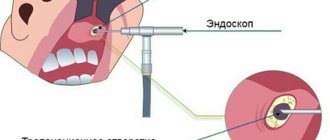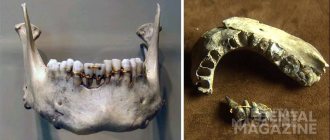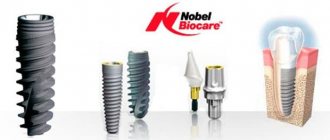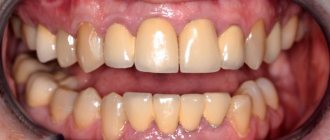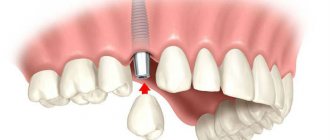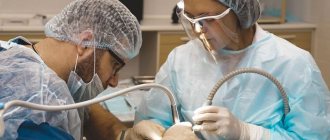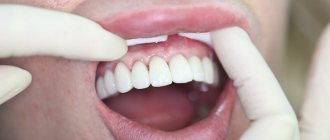One of the fastest methods of restoring a lost tooth is express implantation. The process of installing implants causes considerable anxiety and fear of the painful procedure for many people. In addition, it is generally accepted that this is a rather lengthy process that will require a lot of time and frequent visits to the doctor.
If we talk about classical implantation, then, of course, it will require a certain amount of time, but if you need to quickly install an implant that will hide the absence of one or more teeth, you can resort to express implantation.
The main differences between express implantation and classical methods
Modern technologies and techniques make it possible to make treatment and prosthetics procedures as painless as possible. If you have any problems or diseases, you should consult a doctor as soon as possible to prevent the development of pathologies.
Installation of implants using classical methods requires the presence of bone tissue, but its destruction is a fairly common situation in patients. In some cases, a bone grafting procedure may even be required. The duration of engraftment can be from six to eight months. After which it is already possible to introduce an implant, which will also require time for its engraftment to the bone tissue.
If no complications arise, a permanent crown is installed. Express dental implantation occurs much faster. Sometimes, if the patient does not have any diseases that prevent the operation, the entire procedure can be carried out in a short time, from 1 to 3 days. This is achieved through the use of specially designed mechanisms.
The entire procedure can be briefly described in the following steps:
- examination of the patient for the presence of diseases and the possibility of using the implantation method;
- Under local anesthesia, implants are implanted and impressions are taken;
- fitting and installation of manufactured metal-plastic structures.
The metal-plastic crowns used are installed as temporary elements. Some time after the operation, it is recommended to conduct a re-examination; if the healing process went well and no complications were identified, you can, if desired, replace it with more expensive crowns.
Indications and contraindications for basal prosthetics
Supporters of basal implantation are trying to present this technique as almost a panacea and the list of indications for it is very large. We are not supporters of this method, so we cannot recommend it in any situation.
“The practice of using basal implantation in European countries has shown that it can cause too much damage to the patient’s health. Therefore, in some countries this method was banned at the state level.”
Chief physician of the Academy of Dent Sadov Igor Yuryevich, a specialist with more than 20 years of experience, member of the European Association of Implantologists, member of the International Congress of Dental Implantologists.
The list of contraindications to this method is quite extensive:
- oncopathology;
- decompensated diabetes mellitus;
- tuberculosis;
- untreated arterial hypertension;
- severe disorders of the coagulation system (hypocoagulation);
- pronounced hypertonicity of the masticatory muscles.
Ages under 22 years are a contraindication for this implantation method, since until this age the growth and formation of bones, including jaws, continues
This is interesting! Smoking is a relative contraindication to any type of implantation, due to the fact that smokers have almost 5 times lower chances of successful implantation. This is due to the fact that long-term smoking leads to a decrease in bone density, deterioration of microcirculation in tissues, and slower regeneration. Unscrupulous marketers claim that basal implantation is more effective in smokers, but there is no confirmation of this fact - the percentage of rejection of basal implants in this category of patients is no higher than the percentage of rejection of conventional ones.
Our team of doctors
Maxillofacial surgeon, Implantologist
Bocharov Maxim Viktorovich
Experience: 11 years
Dental surgeon, Implantologist
Chernov Dmitry Anatolievich
Experience: 29 years
Orthopedist, Neuromuscular dentist
Stepanov Andrey Vasilievich
Experience: 22 years
Endodontist, Therapist
Skalet Yana Alexandrovna
Experience: 22 years
Orthopedic dentist
Tsoi Sergey Konstantinovich
Experience: 19 years
Dentist-orthodontist
Enikeeva Anna Stanislavovna
Experience: 3 years
Indications
- If one or more teeth have been lost previously;
- if there is serious damage to the tooth and there is no way to restore it;
- if previous attempts have been made to treat the tooth, which were not successful and there is a need for its removal;
- if the patient has lost all teeth (complete edentia) and needs prosthetics of the entire dentition.
A prerequisite for such surgical intervention is the presence of a sufficient volume of jaw bone tissue.
Advantages of express dental implantation
One of the main advantages is the possibility of implantation without bone tissue augmentation. To do this, implants of the correct shape and size are selected. The implementation can be carried out in a minimally invasive way, i.e. by puncture method.
The installed elements are made in the form of a single structure, including the abutment and the implant body, which protrudes above the gum, so it is possible to immediately install a crown. Due to the integrity of the mechanism, the risk of microbial accumulation and inflammation is minimized.
The cost of express implantation in Moscow may vary in different clinics. When choosing a dental center, you should give preference not only to a more favorable cost, but also to pay attention to the choice of qualified specialists. The price of express implantation is not very different from classical methods, however, due to the reduction in the labor intensity of the process and the work of the doctor, it can sometimes be even cheaper.
Long-term results of basal implantation. Clinical experience.
Author: implantologist-surgeon Sheleg V.L.
This article is the result of many years of accumulated experience in installing basal implants. The article will help patients planning complex dental restoration using immediate loading methods to make the right choice and forget about dental problems for a long time.
Basal implantation
In Belarus, basal implantation began to gain popularity in 2010-2011, after the registration of products from the Swiss brand Ihde Dental AG. The starting point of the era of basal (or one-stage, single-stage, single-phase, express) implantation can be considered the arrival of the company’s founder, Dr. Stephen Ihde, to conduct a demonstration operation at one of the private clinics in Minsk.
I had the opportunity to assist Dr. Ide during an operation that involved multiple tooth extractions and the placement of 18 basal compression implants. Having gained invaluable experience, we, together with our colleagues, orthopedists and dental technicians, have successfully introduced basal implantation into our practice. Over the course of 3 years, we completed several hundred complex works of varying degrees of complexity, with different numbers of implants, different positioning, different prostheses, etc.
Today, after 10 years of observing patients after basal implantation in different clinics, I have the opportunity from my own experience to compare the effectiveness of the technique with other similar implantation techniques with immediate loading.
Short and long term results
Results can be divided into short-term (0-24 months) and long-term (24-100 months). In the first 2 years, the quality of installation of basal implants is of key importance, namely:
• correct positioning, • parallelism, • density of fixation, • fixation into the cortical bone, • and much more, which makes up a high-quality implantation .
Positive short-term results are quite easy to achieve. It is enough for a surgeon to learn a little from experienced colleagues, perform 10-20 operations and evaluate all the technical nuances with his own hands. Negative aspects in short-term results are possible 1) due to gross mistakes by the surgeon due to lack of experience (rarely); 2) due to the individual characteristics of the patient (rarely).
As for long-term results, the picture is somewhat different. The results of basal implants are significantly inferior to classical implants installed and replaced using an immediate loading protocol.
Let's look at several cases and identify several key problems that are highly likely to await the patient after 24 months after basal implantation.
Basal implantation. Case No. 1
December 2014: complex implantation of the upper and lower jaw with basal implants with immediate loading was performed. A temporary reinforced acrylic prosthesis was installed and fixed with temporary cement.
March 2021: a patient from the Russian Federation contacted the KANO clinic with complaints of a broken upper prosthesis.
The patient wrote by e-mail: “I would like to ask you for help in solving the problem. At my place of residence, I was denied warranty service due to the statute of limitations. I am sending you a picture after the destruction of the upper prosthesis. The image shows that the last right and left implants on the upper jaw (in positions No. 18 and No. 28) remained in the body of the bone. You can also see implants that have become loose.”
Comment: in this case, the patient did not perform the prosthesis replacement recommended to him at his place of residence 12-14 months after implantation. Also, according to the patient, he did not correct the prosthesis. As a result, he began to “overload” the right side. The basal implant, installed in the area of the right tubercle of the upper jaw at an angle, could not withstand the load and broke at the bend. The load shifted to the left side and within a week a similar situation occurred on the left side.
Solution: classic implantation protocol in the upper right and left segments. Removal of problematic implants, bone augmentation (open sinus lift) + simultaneous implantation of 3 classic implants + installation of 3 implants in the right side. After 6 months prosthetics of implants with metal ceramics (permanent prosthesis).
Basal implantation. Case No. 2
March 2014: comprehensive implantation of the upper jaw with basal implants was carried out, 3 basal implants were installed on the left and right sides of the lower jaw. February 2015: metal-acrylic prostheses were replaced with metal-ceramic ones. Testing of the implants showed 100% stability (according to the patient).
December 2021: Contacted the KANO clinic. Complaints about the mobility of the upper prosthesis. An inspection has been scheduled. Micromobility of the prosthesis was revealed. Observation 2 weeks. Mobility has increased significantly. The decision was made to remove the prosthesis. Lack of stability was revealed in 3 implants in the area of teeth 22, 23, 24.
A treatment plan has been drawn up. The implants were removed + 3 basal implants were installed, temporary prosthetics were performed using a metal-acrylic prosthesis with fixation using temporary cement.
July 2021: a complaint was received about the mobility of the upper prosthesis. The examination revealed mobility of the implants in the cusp areas in the area of teeth No. 18, 28.
Together with the patient, it was decided to remove all basal implants and carry out work according to the immediate loading protocol on classic implants with multi-unit abutments - ALL-ON-6 (all on six implants). The work was completed according to the agreed plan. A temporary prosthesis with screw fixation was installed (without restrictions on food intake). Detailed care instructions are provided + an irrigator as a gift (promotion from the equipment supplier!).
July 2021: Follow-up inspection. Removal of the prosthesis. Lack of implant mobility. No complaints.
Basal implantation. Case No. 3
September 2021: total rehabilitation of the upper jaw was performed using one-stage basal implants, without gum incision. 9 implants were installed, 2 of which were in the tuberosities of the maxillary bone.
November 2021: the patient contacted the KANO clinic for advice regarding the mobility of the prosthesis. At the site of implantation, the patient did not receive any practical proposals to correct the situation. After carefully removing the upper jaw prosthesis, the implant on the right side was broken and was partially removed along with the prosthesis.
Why did it break? Before installing basal implants, surgeons often bend them (by hand or with pliers) to achieve parallelism with other implants. In 90% of cases, such manipulation is performed “by eye”.
This slightly barbaric method is required due to the fact that basal implants are single-component, because... the implant and abutment are one. Unlike classic implants, in which an abutment can be selected separately for each implant.
As the structure is used and chewed continuously, a microcrack gradually appears in the bending area, which ultimately leads to implant failure.
Why is All-On-4/6 better in the context of such breakdowns?
All-On-4/6 operations, classic, two-piece implants are used. Consisting of the implant itself and the abutment. The bottom line is that for techniques with immediate loading, special angular abutments (multi-unit abutments) have been developed.
Thus, if the surgeon needs to install the implant at an angle, he does not need to bend the structure with his own hands. After installing the implant at an angle, a multiunit abutment with the appropriate angle of inclination is screwed to it.
November 2021: additional classical implants were installed in the area of teeth 17.27. The part of the basal implant remaining in the bone in area No. 18 was removed. A temporary prosthesis was made.
April 2021: after 5 months, a follow-up examination showed complete integration of the classical implants. Combined metal-ceramic prosthetics was performed.
Patient complaint: mobility of the lower left bridge.
Solution: CT and OPTG revealed no problems. The prosthesis was carefully removed. Mobility of 2 out of 4 basal implants was revealed. During extraction, one of the implants broke. 1 classic implant installed. After integration, after 3 months, it was decided to carry out combined prosthetics on basal and classic implants (due to the patient’s financial capabilities).
Contraindications
Like any other procedure related to prosthetics, express dental implantation has some contraindications. First of all, the group of restrictions includes diseases of the blood and connective tissues. Due to the fact that the implantation is carried out directly into the bone tissue, if the patient has bone diseases and osteoporosis, the operation also becomes impossible. Before installation, it is recommended to bring the immune system back to normal so that the healing process occurs as quickly as possible and without complications. It is not recommended to perform prosthetics for children and adolescents whose physiological body is still in the process of formation and is not ready for such procedures.
Author:
Advantages and disadvantages
Advantages:
- Minimal surgical intervention and a short recovery period do not cause much discomfort to the patient.
- Significant reduction in implantation time. An experienced implantologist can perform it in just a few minutes.
- Immediately after the operation, the patient has virtually no pain and swelling of the soft tissues. In this case, there is no disruption of the blood supply to the gums and bones, which significantly increases the chances of a successful outcome.
- The final prosthetics are performed on the day of implant installation. At the same time, loads can be placed on orthodontic structures almost immediately and the patient does not have to significantly change his lifestyle.
- Implantation can be performed immediately after the old tooth is removed.
- The number of doctor visits and the cost of treatment are reduced.
Flaws:
- The surgeon is not able to visually monitor the implant insertion process and the condition of the bone. Therefore, there is a risk of incorrect selection of elements.
- It is impossible to carry out implantation with small volumes of bone tissue without pre-building it.
- There are a large number of contraindications for which this method cannot be used.
Prosthetic options within the framework of the express method of dentition restoration
Express implantation provides several different options for restoring the dentition, depending on the state of health, the doctor’s recommendations and the patient’s capabilities.
- Mini-implantation involves the use of short and thin rod bases, which provide the most accurate fixation of the prosthesis. The advantage of this method of prosthetics is that there is little trauma. However, there are also disadvantages. Thus, mini-dentures do not have exceptional strength; they can only be worn with removable dentures and avoid increased chewing loads. This method of express prosthetics can hardly be called the most reliable and most modern.
- Simultaneous implantation involves the simultaneous removal of a decayed tooth and the implantation of an artificial root-implant. Thus, during one visit, the patient can undergo 2 procedures. For example, if the restoration is performed in the smile area, the prosthesis can be put on immediately after implantation of the artificial root. When it comes to chewing teeth, you will need to walk around with a removable denture for some time.
- One-stage implantation allows you to restore from 2 to 6 teeth simultaneously, depending on the degree of destruction of the dentition. The express method is justified for both single and multiple teeth prosthetics.
Sequence of implantation
The preparatory stage involves assessing the patient's health status. If there are no contraindications to prosthetics, the doctor will order a computed tomography scan.
Since any intervention in the human body is fraught with negative consequences, research should not be neglected.
- Passing the necessary tests for healthy patients involves only urine and blood tests. Older patients may additionally need to provide tests characterizing hormonal levels.
- In the presence of chronic diseases, the opinion of a competent specialist may be required to prevent complications after the express intervention.
- Sanitation of the oral cavity.
- Choosing the optimal prosthetic technique. Here, a specialist assesses the patient’s health status and offers him the most appropriate methods for quickly restoring the dentition.
- The surgical stage of prosthetics involves the implantation of implants. The duration of this procedure is no more than 4 hours.
- After installing the artificial base, the doctor may invite the patient to monitor his own health at home and prescribe the installation of prostheses 2-3 days after the implantation of the artificial root.
Cost of express prosthetics
Traditionally, the cost of prosthetics is calculated individually for each patient. Because it depends on a number of changing factors and circumstances. In addition to the number of damaged teeth, the doctor and the patient must decide on the method of fixing the implant, select the optimal models of implants and choose the most suitable fastenings for the dentures.
The estimated cost of restoring one tooth starts from 30 thousand rubles. To understand what the costs are in your case, we recommend making an appointment and a free consultation with specialists at our clinic.



